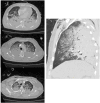Severe postoperative negative pressure pulmonary edema: a case report
- PMID: 39482603
- PMCID: PMC11529180
- DOI: 10.1186/s12871-024-02785-2
Severe postoperative negative pressure pulmonary edema: a case report
Abstract
Background: Postoperative negative pressure pulmonary edema (NPPE) can occur in any patient undergoing general anesthesia. There are several risk factors for it, especially postoperative laryngospasm. The disease is usually benign and quickly reversible. In our case the severity and need for advanced critical care therapy was unusual.
Case: We report a severe case of postoperative negative pressure pulmonary edema in a 62-year-old male patient undergoing elective right-sided retroperitoneoscopic adrenalectomy. The patient developed a severe case of acute respiratory distress syndrome (ARDS) after postoperative laryngospasm, possibly in conjunction with a suspected anaphylactic reaction. The patient was consequently treated with a combination of invasive airway pressure release ventilation (APRV) and a prone positioning regimen. After drastic improvement in respiratory function, the patient was discharged from the intensive care unit after 10 days and from the hospital after 14 days.
Conclusion: NPPE is a rare but relevant complication of anesthesia and laryngospasm. The disease can basically occur in any patient undergoing general anesthesia and therefore should be considered.
Keywords: APRV Ventilation Mode; ARDS; Intraoperative complications; Laryngospasm; Pulmonary edema.
© 2024. The Author(s).
Conflict of interest statement
The authors declare no competing interests.
Figures


References
-
- Bhattacharya M, Kallet RH, Ware LB, Matthay MA. Negative-Pressure Pulmonary Edema. Chest. 2016;50:4:927–33. - PubMed
-
- Alb M, Tsagorgiorgas C, Meinhardt J. Negative-pressure pulmonary edeme (NPPE). Anästhesiol Intensivmed Notfallmed Schmerzther. 2006;41:64–78. - PubMed
-
- Krodel DJ, Bittner EA, Abdulnour R, Brown R, Eikermann M. Case scenario: Acute postoperative negative pressure pulmonary edema. Anesthesiology. 2010;113(1):200–7. - PubMed
Publication types
MeSH terms
LinkOut - more resources
Full Text Sources
Medical

